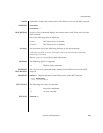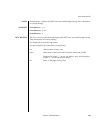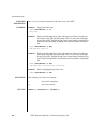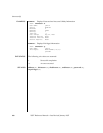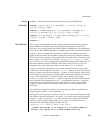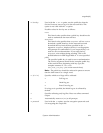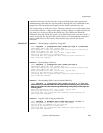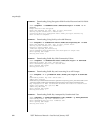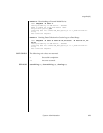
snapshot(8)
System Administration 369
NAME snapshot - collect and transfer environment, log, error, and FRUID data
SYNOPSIS snapshot -d device [-r][-e [-P password]] [-L {F|I|R}][-l][-v][[-q]
-{y|n}][-S time [-E time]]
snapshot -t user@host: directory [-e [-P password]] [-k host-key][-l][-L
{F|I|R}][-p password][-v][[-q] -{y|n}][-S time [-E time]]
snapshot -T [-D directory][-e [-P password]] [-k host-key][-l][-L {F|I|R}]
[-v][[-q] -{y|n}][-S time [-E time]]
snapshot -h
DESCRIPTION The snapshot(8) command provides a data-collection mechanism that enables
rapid, reliable, and flexible retrieval of diagnostic information on the Service
Processor. snapshot(8) collects the following data: Configuration, Environmentals,
Logs, Errors, and FRUID information. It transfers data to the specified destination.
snapshot opens an output file, the name of which is automatically generated
based on the host name and IP address assigned to the Service Processor and the
UTC time (in hours, minutes, and seconds) and date on the Service Processor at the
time snapshot is invoked. For example: jupiter_10.1.1.1_2006-07-08T22-
33-44. snapshot does not support user-specified file names for the output file. As
files and command output are collected from the Service Processor, snapshot
compresses the output data and writes it in the format of a .zip archive.
snapshot stores the collected data on a remote network host or on an external
media device, based upon the use of the -t, -T or -d option. To store the collected
data on a remote network host using the -t option, you must specify a host name
(or IP address), a target directory on the remote network host, and the user name of
a user on the remote host. If you have already set an archive target using
setarchiving(8), you can use the -T option to store the data on a remote network
host using that same information, or use -T in conjunction with the -D option to
change only the target directory. When storing data on a remote network host,
snapshot opens a network connection using SSH to act as a data pipe to the
remote file.
It is possible to restrict data collection on some larger log files to a specific date
range using the options -S and, optionally, -E.
Encrypted network protocols, such as SSH and SSL, are used for transmission of the
data across a network connection. The entire .zip archive itself can be encrypted
using the -e flag. To decrypt a .zip archive that has been encrypted with this
process, use the encryption password given to snapshot with the openssl
command. The following example decrypts the file
jupiter_10.1.1.1_2006-07-08T22-33-44.zip.e:
% openssl aes-128-cbc -d -in jupiter_10.1.1.1_2006-07-08T22-33-
44.zip.e -out jupiter_10.1.1.1_2006-07-08T22-33-44.zip



